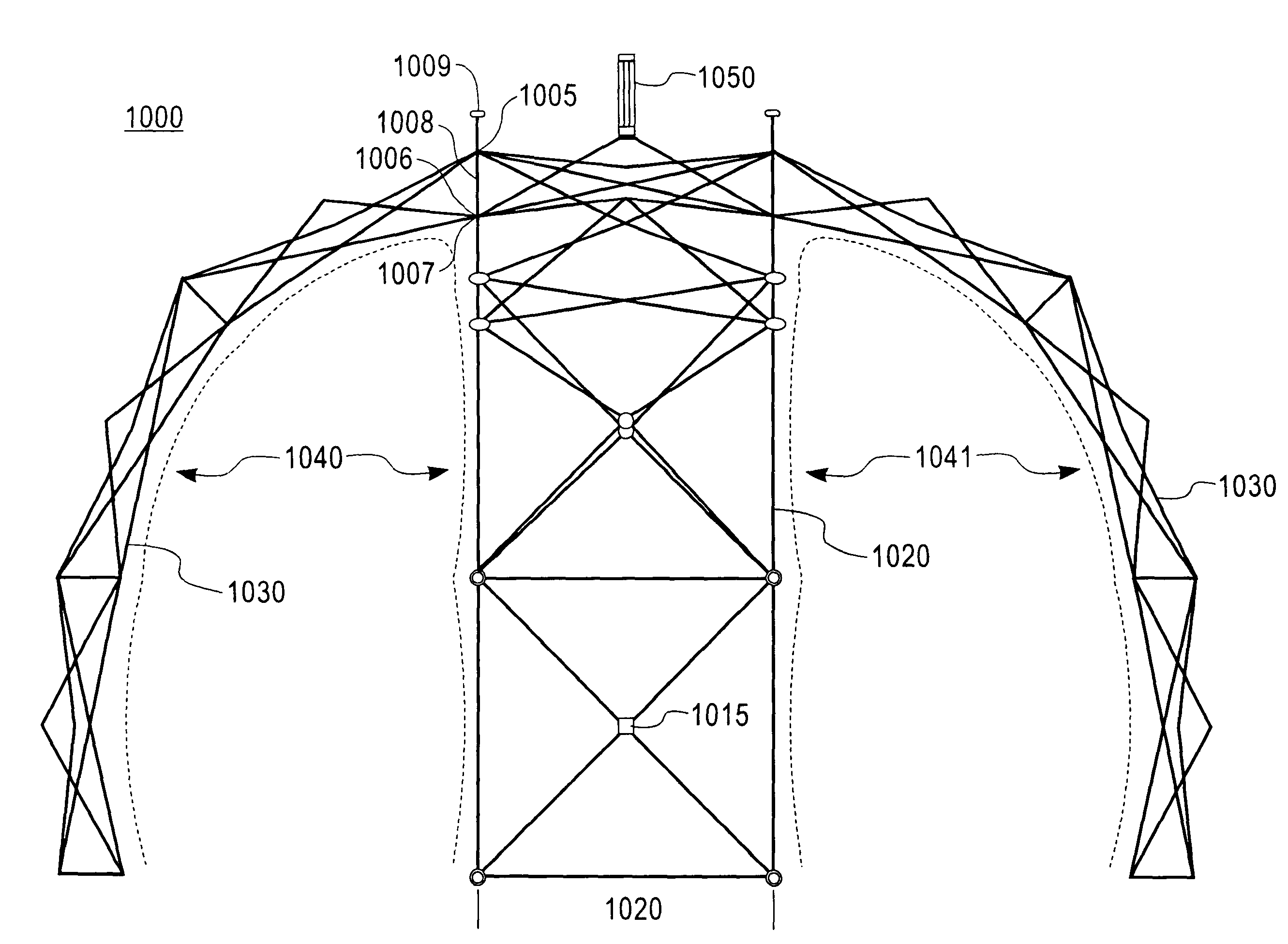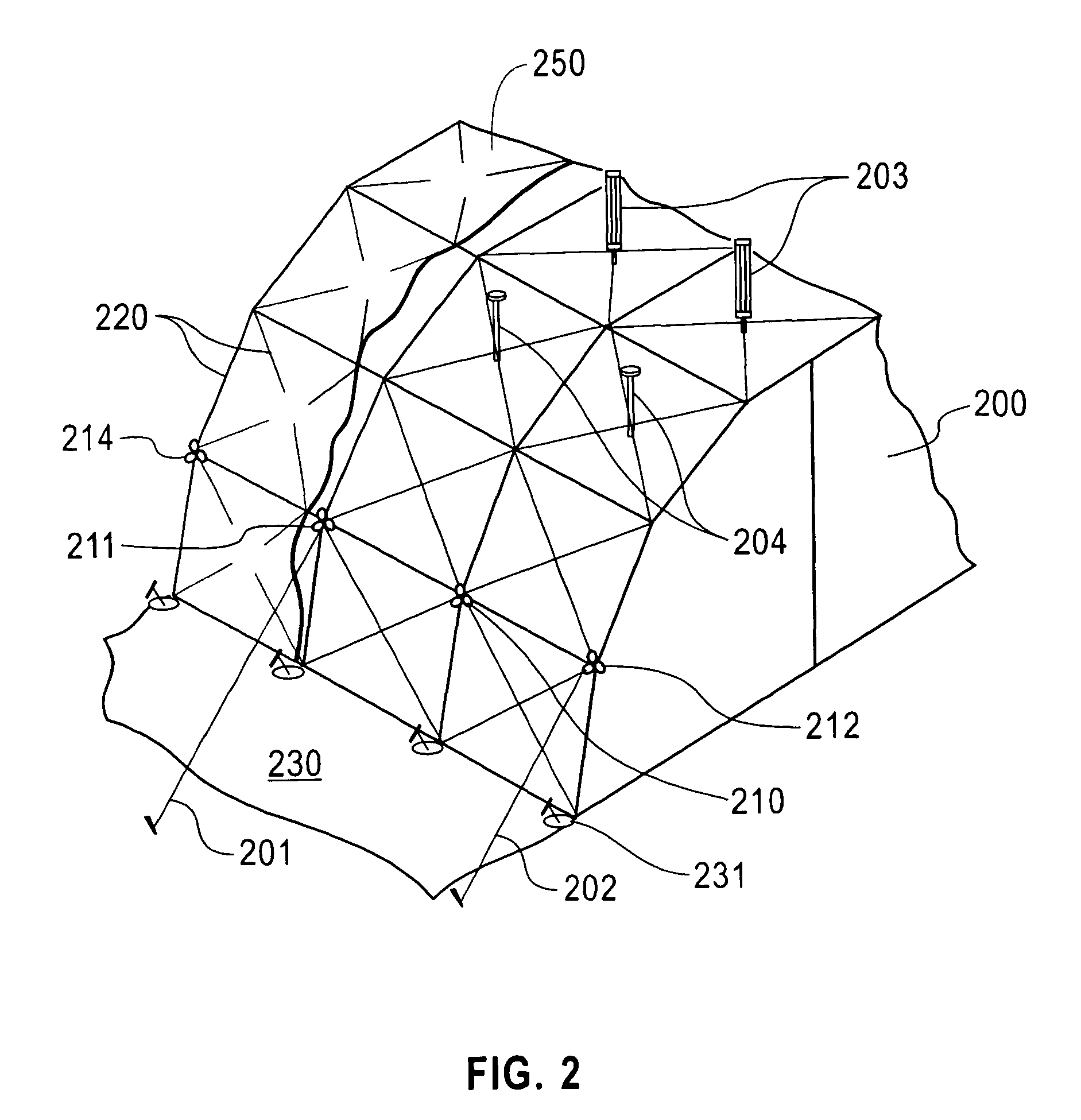Collapsible shelters with and without a floating hub
a shelter and hub technology, applied in the direction of buildings, buildings, constructions, etc., can solve the problems of not being easily replaced, not being able to easily replace the tube members of the structure, and not being able to meet the needs of the user,
- Summary
- Abstract
- Description
- Claims
- Application Information
AI Technical Summary
Benefits of technology
Problems solved by technology
Method used
Image
Examples
example 1
[0140]BBABB Refer to FIGS. 17 and 23
[0141]Given: a length L The vertical and horizontal dimension of a strut.
[0142]Given: A full arch BBABB with four B Quads forming four isosceles triangles having an vertex angle of 180° / 4=θ3 and where θ2=θ3 / 2 and θ1+θ2=90° or θ1=(180−θ3) / 2 and connecting at the center with the A Quad.
[0143]Note: There are three center points for this configuration; one for each arch and the center with two different radii. Refer back to FIG. 2.
[0144]Therefore, one side or leg of the isosceles triangle (x+d1) is part of the total width of the shelter W and can be calculated as follows where:
W=L×2(d1)[0145]To find the distance d1, bisect angle θ3 and form a right triangle at the base of the isosceles triangle dividing L into two part: L / 2[0146]Using the Law of Cosines where Cosine θ1=L / 2 / (x+d1) then,
(x+d1)=L / 2 / Cos θ1 [0147]To find the final d1 we need to find x. And the distance x can be calculated from the law of Cosine where Cos θ1=x / L / 2 and x=L / 2 (Cos θ1) and the...
example 2
[0150]BBBBBBB: Refer to FIGS. 17 and 24
[0151]Given: A strut length L
[0152]Given: A full arch with all B Quads: BBBBBBB forming a semi-circle with seven Quads forming seven isosceles triangles each with a vertex angle of 180° / 7=θ3 and θ1=(180−θ3) / 2 and θ2=θ3 / 2
[0153]Note: There is one center point. All seven isosceles triangles legs have the same radius.
W=2(d1)[0154]To find the leg (x+d1), bisect angle Ø3 at the vertex and form a right triangle at the base of the isosceles triangle dividing L into two part: L / 2 and L / 2[0155]Using Law of Cosines where Cos θ1=L / 2 / (x+d1) then[0156]And (x+d1)=L / 2 / Cos θ1 [0157]To find the effective distance (d1) we need to find x. And the distance x can be calculated where Cos θ1=x / L and therefore[0158]x=Cos θ1 (L) and therefore the effective distance (d1) is less x[0159]To calculate the effective height h1, which is less than the radius d1, using the formula:[0160]Sin θ1=h1 / d1 and therefore h1=Sin θ1 / (d1)
example 3
[0161]ABABA: Refer to FIGS. 17 and 25
[0162]Given: A length L
[0163]The procedure to calculate height and width with this Quad configuration is similar to the previous examples. The added height is increased by a factor of L and the added width is increased by a factor of L.
[0164]The quads can be used to create almost any size structure. As depicted in the drawings FIGS. 18 to 25, the basic A and B quads can be connected together in various combinations to create an arch-like structure. Either of the quads can be any size depending upon the length of strut and the ratio of these lengths plus the positioning of the scissor point allowing the struts to articulate.
[0165]The quads, whether A or B comprise a substantially square structure having a base, two sides and a top. They are designated as an “A” quad or a “B” quad depending upon the location of the scissor points along the length of the struts of the subassembly, as explained in greater detail hereinafter. The struts used in a suba...
PUM
 Login to View More
Login to View More Abstract
Description
Claims
Application Information
 Login to View More
Login to View More - R&D
- Intellectual Property
- Life Sciences
- Materials
- Tech Scout
- Unparalleled Data Quality
- Higher Quality Content
- 60% Fewer Hallucinations
Browse by: Latest US Patents, China's latest patents, Technical Efficacy Thesaurus, Application Domain, Technology Topic, Popular Technical Reports.
© 2025 PatSnap. All rights reserved.Legal|Privacy policy|Modern Slavery Act Transparency Statement|Sitemap|About US| Contact US: help@patsnap.com



